Recent events such as a terrorist attack in the center of Tel Aviv, Netanyahu’s Moscow visit, his meeting with President Putin, and the opening of an exhibition, “Open A Door to Israel,” all led the author to book an immediate flight to Tel Aviv the following day.
Having visited two of Israel’s neighbors, Jordan and Egypt – in previous years, this time the focus of the trip was exploring the Biblical “Promised Land,” the Holy Land of three Abrahamic faiths, numerous Christian sites, Russian emigres in Israel, and getting a firsthand view of the Israeli-Palestinian conflict.
Tel Aviv is the second most populous city after Israel’s capital, Jerusalem. Since most countries do not recognize Jerusalem as the capital, most embassies and diplomatic offices are in Tel Aviv. The city was built on the Mediterranean coast and with a long stretch of beaches, lines of tall palm trees, an impressive board walk with special lanes for bicycles and runners, waterfront promenade lined with restaurants and shops, it resembles parts of Miami. One of Tel Aviv’s numerous attractions are its stark 1930s Bauhaus buildings scattered throughout the White City architectural area, which is recognized by UNESCO as a World Heritage site. Another German-influenced site of Tel Aviv is Sarona, the German Templars village of newly renovated stone houses with red-shingled roofs in the heart of Tel Aviv. It is the area where the latest terror attack took place in one of the Sarona market’s upscale cafés, “Max Brenner.”
The author visited the scene of the attack, saw the table where the attackers looking like regular businessmen from the nearby office buildings, sat before they started shooting people and ending up killing four Israelis. The young Israeli girl behind the counter of the Max Brenner café described in detail how everything took place and she seemed very calm as if describing an ordinary event from her daily life. When the author asked the café employee how it feels being under the constant threat of such attacks, she said that they are got used to that and that the country is under a “constant state of emergency,” but life goes on. Indeed it does as children played, parents chatted, couples walked hand in hand, and exercisers on bikes and runners went about their routines.
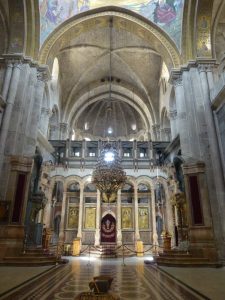 Besides today’s Russian speaking emigres in Israel, Russian influence is noticeable everywhere. For example, the Russian Compound which was built in 1860-90 in Jerusalem is one of the oldest districts in the city center and includes a large Russian Orthodox Church and former pilgrimage hostels. Russian pilgrims have been visiting the Holy Land since the earliest years of Christianity in Russia. In fact, prior to the 1917 Revolution, the Russian Orthodox Church sent more pilgrims to the Holy land than any other denomination, a practice that has seen resurgence in the last twenty years. The Russian Palestine Society, founded in 1860, organized pilgrimages to the Holy Land and purchased property in Jerusalem and Nazareth. Nowadays, various properties in Israel are owned by either the Moscow Patriarchate or the Russian Orthodox Church Outside Russia.
Besides today’s Russian speaking emigres in Israel, Russian influence is noticeable everywhere. For example, the Russian Compound which was built in 1860-90 in Jerusalem is one of the oldest districts in the city center and includes a large Russian Orthodox Church and former pilgrimage hostels. Russian pilgrims have been visiting the Holy Land since the earliest years of Christianity in Russia. In fact, prior to the 1917 Revolution, the Russian Orthodox Church sent more pilgrims to the Holy land than any other denomination, a practice that has seen resurgence in the last twenty years. The Russian Palestine Society, founded in 1860, organized pilgrimages to the Holy Land and purchased property in Jerusalem and Nazareth. Nowadays, various properties in Israel are owned by either the Moscow Patriarchate or the Russian Orthodox Church Outside Russia.
About 10 km (6.2 miles) south of Jerusalem is located Bethlehem, a Palestinian city in the central West Bank, in the Palestinian Territories. The Hebrew signs on storefronts that were seen previously in Tel Aviv and Jerusalem are here replaced by signs in Arabic, while the yellow license plates of Israel are replaced by the green plates of the Palestinian Authority. There was a striking difference between the Jewish settlements and the Palestinian: there were many large villas with flat roofs for one family ( the Palestinian houses) as it is customary to add another level when a son in a Palestinian family gets married. There were no slums in Palestine as it often portrayed in the press, but rather solid houses and villas, some of them worth several million US dollars. As it turned out, Palestinians in the West Bank and Gaza Strip receive one of the highest levels of aid in the world coming from the Western donors (predominantly the US) and the Arab states. The trash around the villas is part of the Arab customs to take off shoes before entering their pristine houses, but dump the garbage outside the walls of their compounds. The Palestinian Arabs keep their houses and “private spaces” clean, but do not care much about the environment of the city where they live.
Bethlehem. The majority of the Bethlehem’s population is Muslims with a small Palestinian Christian community. The Church of the Nativity was the author’s main reason to visit Bethlehem, as is the case for many Christian pilgrims visiting the Holy places during the Christmas season and beyond. Apparently, not all tour guides are allowed to visit Palestine, so it is helpful to know Arabic or have an interpreter with you, such as when we visited Jericho, the oldest city on the planet dating to 9000 years BCE. The city is known as the place where Jesus of Nazareth passed through, healed the blind beggar, and persuaded Zacchaeus, a tax collector, to repent of his sins. The road between Jerusalem and Jericho is also known as the setting of the Parable of the Good Samaritan, from which the expression “good Samaritan” stems.
While traveling through Palestine on the way to the Greek Orthodox Monastery of the Temptation, overlooking the city of Jericho, one of the tourists asked the tour guide if it was safe to be there in a Mercedes minivan with Israeli license plates. The tour guide, who spoke both Hebrew and Arabic and had a permit to visit Palestine, reassured our small mixed group of tourists from Argentina, the U.S., Ukraine, and Russia that things can happen anywhere, even in the U.S., giving an example of the recent tragedy in Orlando’s Pulse night club where an American-born Muslim terrorist killed 49 people and injured 50.
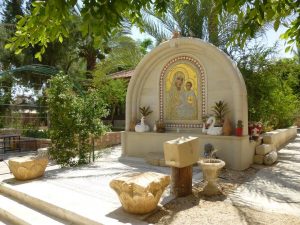 The Jericho cable car is a way to reach the Temptation Temple and is operated by Palestinians. When our cable car suddenly stopped midway, some tourists in that car were visibly nervous. The Monastery of the Temptation, an Orthodox Christian monastery with just one monk permanently living there, is located on the Mount of Temptation on the cliff overlooking Jericho and the Jordan Valley. It is believed that the Monastery houses the small cave where Jesus was tempted by Satan to turn stones into bread, but Jesus replied that “’Man shall not live on bread alone, but on every word that comes from the mouth of God” and then spent forty days and forty nights fasting and meditating.
The Jericho cable car is a way to reach the Temptation Temple and is operated by Palestinians. When our cable car suddenly stopped midway, some tourists in that car were visibly nervous. The Monastery of the Temptation, an Orthodox Christian monastery with just one monk permanently living there, is located on the Mount of Temptation on the cliff overlooking Jericho and the Jordan Valley. It is believed that the Monastery houses the small cave where Jesus was tempted by Satan to turn stones into bread, but Jesus replied that “’Man shall not live on bread alone, but on every word that comes from the mouth of God” and then spent forty days and forty nights fasting and meditating.
From Jericho, with its magnificent Temptation Temple, on the way to Wadi Kelt where St. George’s Monastery is located, there is a notable site called Qasr el Yehud. Qasr el Yahud is the place where Jesus was baptized by John the Baptist in the Jordan River Valley, Palestine. It is quite remarkable that the official border between Jordan and Israel is that rather narrow part of the Jordan River which can easily be crossed by swimming. Two young Israeli soldiers were rather friendly and allowed our group and other tourists to make photos with them. The Jordanian soldiers on the other side of Jordan River were just within a stone’s throw of us and were watching our group as some were stepping into the Jordan River, some were taking selfies with the Israeli soldiers under the scorching sun. The Israeli Army, a requirement of national service for every Israeli, is considered by young Israelis as an honorable thing to do for their country, even though women are drafted for two years and men for three.
An interesting fact is that on the road to Qasr el Yehud one passes many signs on both sides saying, “Danger! Mines!” When Israel gained control of Qasr al-Yahud from Jordan in the 1967 war, the Israelis mined the entire area of the West bank of the Jordan River to ward off attacks from across the border. The subsequent peace treaty with Jordan signed in 1994 ensured safety of the border for more than two decades. The site is closed for visitors except for the narrow path surrounded by the midfields where the author’s car was traveling. It is estimated that some 500,000 Christian pilgrims (Russian, Greek, Ethiopian, etc.) visit the site each year, but that number will rise after the minefields are cleared.
After visiting Christ’s baptism site, our group headed towards Wadi Qelt. Wadi Qelt is a valley in the West Bank where St. George Monastery is located. The monastery is a sixth-century, stone-carved, cliff-hanging complex, which resembles Petra, in Jordan. St. George monastery is an active monastery inhabited by Orthodox monks. Visitors can reach the monastery by a pedestrian bridge across Wadi Qelt.
Heading north from Wadi Qelt is the Sea of Galilee, also known as the Lake of Kineret, Israel’s largest reservoir of fresh water. It is an important source of drinking water and a tourism spot. According to the Christian tradition, Jesus lived and performed miracles in Galilee and the surrounding region. It is believed that he walked on the water here and the miracle of the fishes and the loaves occurred in Capernaum nearby. As for the Sea of Galilee being an important source of fresh water, it is amazing that Israel managed to turn deserts into oases and become a major producer of fresh produce employing some five percent of the population given that water has been scarce and the soil is not the most suitable for agriculture.
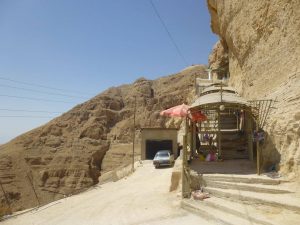 Nazareth, in the lower Galilee, is the cradle of Christianity and the city where the archangel Gabriel told Mary that she would bear a child by the power of the Holy Spirit, as well as the place where Jesus spent his childhood and youth. The city is also known as the “Arab capital” of Israel as its inhabitants are predominantly Israeli Arabs. The city is one of the Christian pilgrimage sites in Israel featuring The Church of the Annunciation, the Church of St. Gabriel, and other important Christian sites among its more than thirty churches and monasteries. Visiting Nazareth is like reliving history and experiencing the Biblical sites firsthand.
Nazareth, in the lower Galilee, is the cradle of Christianity and the city where the archangel Gabriel told Mary that she would bear a child by the power of the Holy Spirit, as well as the place where Jesus spent his childhood and youth. The city is also known as the “Arab capital” of Israel as its inhabitants are predominantly Israeli Arabs. The city is one of the Christian pilgrimage sites in Israel featuring The Church of the Annunciation, the Church of St. Gabriel, and other important Christian sites among its more than thirty churches and monasteries. Visiting Nazareth is like reliving history and experiencing the Biblical sites firsthand.
No trip to Israel would be complete without visiting Haifa, Caesarea and Acre. Haifa boasts breathtaking views from Mt Carmel (546 m), beautiful gardens of the World Center of the Bahai Faith, and is a symbol of co-existence and tolerance of its residents from the three major religions – Judaism, Christianity and Islam. The Christian presence in Haifa is demonstrated by numerous churches such as Saint Mary’s Greek Orthodox Church, the church of Stella Maris Carmelite Monastery, the Carmelite Church of the Prophet Elijah, and many others. South of Haifa is Caesarea, a town built by Herod the Great, who was a controversial figure in history known for his colossal building projects as well as his order of the Massacre of Innocents after the birth of Jesus.
North of Haifa is the city of Acre (Akko), one of the oldest cities in the world, dating back to the time of the Pharaoh Thutmose III (1504-1450 BCE). Its Old town is a UNESCO heritage site. The old city of Akko’s population is mostly Arab Muslim (including several Bedouin families), with some Arab Christian neighborhoods in close proximity.
Finally, it is worth noting the role of the Kibbutz (plural Kibbutzim) in Israel and its development. The Kibbutzim (Hebrew for “communal settlement”) were similar to the Soviet “Kolkhoz” and many were formed by immigrants from Russia and the former Soviet Union. This unique community is dedicated to mutual aid and social justice, based on the principles of joint ownership of property, equality, and cooperation in production, consumption and education. Its central idea is “from each according to his ability, to each according to his needs,” which is similar to the Marxist ideas. The combination of hard work and advanced farming methods (drip irrigation method mentioned earlier) allowed Kibbutz farmers to achieve remarkable results, accounting for a large percentage of Israel’s agricultural output to this day.
As the saying goes, “It is better to see once than to hear a hundred times.” Visiting Israel confirmed this saying. Israel is truly unique for the number of Holy places considered sacred by so many religions. However, it is also a land of hard working people who simply want to live their lives, raise their children, and be happy and secure.
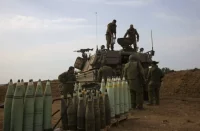
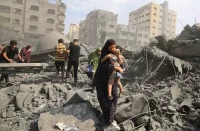












Good and factual article.If there are doubts , why not to take a trip to Israel and Palestine?